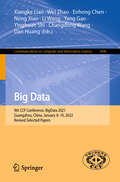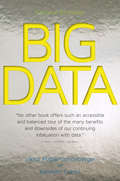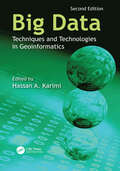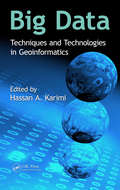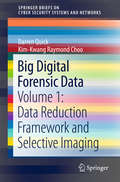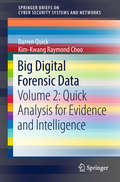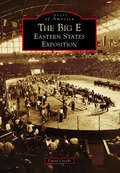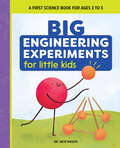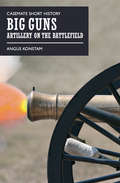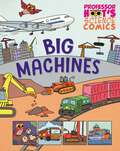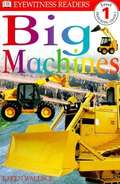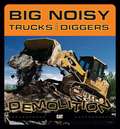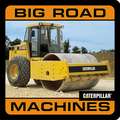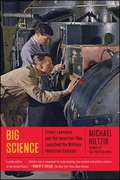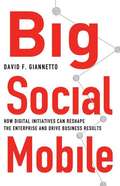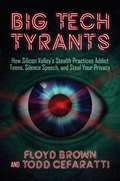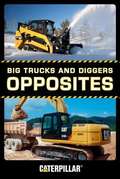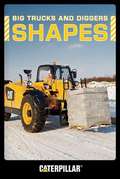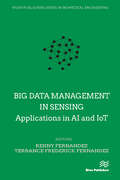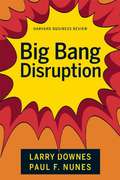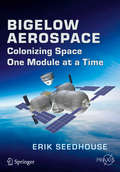- Table View
- List View
Big Data: 9th CCF Conference, BigData 2021, Guangzhou, China, January 8–10, 2022, Revised Selected Papers (Communications in Computer and Information Science #1496)
by Li Wang Yang Gao Wei Zhao Yinghuan Shi Nong Xiao Dan Huang Xiangke Liao Enhong Chen Changdong WangThis book constitutes the proceedings of the 9th CCF Conference on Big Data, BigData 2021, held in Guangzhou, China, in January 2022. Due to the COVID-19 pandemic BigData 2021 was postponed to 2022. The 21 full papers presented in this volume were carefully reviewed and selected from 66 submissions. They present recent research on theoretical and technical aspects on big data, as well as on digital economy demands in big data applications.
Big Data: A Revolution That Will Transform How We Live, Work, and Think
by Viktor Mayer-Schönberger Kenneth Cukier<P>A revelatory exploration of the hottest trend in technology and the dramatic impact it will have on the economy, science, and society at large.Which paint color is most likely to tell you that a used car is in good shape? How can officials identify the most dangerous New York City manholes before they explode? And how did Google searches predict the spread of the H1N1 flu outbreak? The key to answering these questions, and many more, is big data. <P> “Big data” refers to our burgeoning ability to crunch vast collections of information, analyze it instantly, and draw sometimes profoundly surprising conclusions from it. This emerging science can translate myriad phenomena—from the price of airline tickets to the text of millions of books—into searchable form, and uses our increasing computing power to unearth epiphanies that we never could have seen before. <P> A revolution on par with the Internet or perhaps even the printing press, big data will change the way we think about business, health, politics, education, and innovation in the years to come. It also poses fresh threats, from the inevitable end of privacy as we know it to the prospect of being penalized for things we haven’t even done yet, based on big data’s ability to predict our future behavior.In this brilliantly clear, often surprising work, two leading experts explain what big data is, how it will change our lives, and what we can do to protect ourselves from its hazards. Big Data is the first big book about the next big thing.
Big Data: Techniques and Technologies in Geoinformatics
by Hassan A. KarimiOver the past decade, since the publication of the first edition, there have been new advances in solving complex geoinformatics problems. Advancements in computing power, computing platforms, mathematical models, statistical models, geospatial algorithms, and the availability of data in various domains, among other things, have aided in the automation of complex real-world tasks and decision-making that inherently rely on geospatial data. Of the many fields benefiting from these latest advancements, machine learning, particularly deep learning, virtual reality, and game engine, have increasingly gained the interest of many researchers and practitioners. This revised new edition provides up-to-date knowledge on the latest developments related to these three fields for solving geoinformatics problems.FEATURES Contains a comprehensive collection of advanced big data approaches, techniques, and technologies for geoinformatics problems Provides seven new chapters on deep learning models, algorithms, and structures, including a new chapter on how spatial metaverse is used to build immersive realistic virtual experiences Presents information on how deep learning is used for solving real-world geoinformatics problems This book is intended for researchers, academics, professionals, and students in such fields as computing and information, civil and environmental engineering, environmental sciences, geosciences, geology, geography, and urban studies.
Big Data: Techniques and Technologies in Geoinformatics
by Hassan A. KarimiBig data has always been a major challenge in geoinformatics as geospatial data come in various types and formats, new geospatial data are acquired very fast, and geospatial databases are inherently very large. And while there have been advances in hardware and software for handling big data, they often fall short of handling geospatial big data ef
Big Digital Forensic Data: Volume 2: Quick Analysis For Evidence And Intelligence (SpringerBriefs On Cyber Security Systems And Networks)
by Kim-Kwang Raymond Choo Darren QuickThis book provides an in-depth understanding of big data challenges to digital forensic investigations, also known as big digital forensic data. It also develops the basis of using data mining in big forensic data analysis, including data reduction, knowledge management, intelligence, and data mining principles to achieve faster analysis in digital forensic investigations. By collecting and assembling a corpus of test data from a range of devices in the real world, it outlines a process of big data reduction, and evidence and intelligence extraction methods. Further, it includes the experimental results on vast volumes of real digital forensic data. The book is a valuable resource for digital forensic practitioners, researchers in big data, cyber threat hunting and intelligence, data mining and other related areas.
Big Digital Forensic Data: Volume 2: Quick Analysis for Evidence and Intelligence (SpringerBriefs on Cyber Security Systems and Networks)
by Kim-Kwang Raymond Choo Darren QuickThis book provides an in-depth understanding of big data challenges to digital forensic investigations, also known as big digital forensic data. It also develops the basis of using data mining in big forensic data analysis, including data reduction, knowledge management, intelligence, and data mining principles to achieve faster analysis in digital forensic investigations. By collecting and assembling a corpus of test data from a range of devices in the real world, it outlines a process of big digital forensic data analysis for evidence and intelligence. It includes the results of experiments on vast volumes of real digital forensic data. The book is a valuable resource for digital forensic practitioners, researchers in big data, cyber threat hunting and intelligence, data mining and other related areas.
Big E, The: Eastern States Exposition (Images of America)
by David CecchiThe Eastern States Agricultural and Industrial Exposition was founded more than a century ago to �promote the agricultural and industrial development of the eastern states.� Held at the fairgrounds in West Springfield, Massachusetts, the inaugural event was the National Dairy Show in 1916, followed by what would become known as �The Big E,� the combined �state fair� of the six New England states: Connecticut, Massachusetts, Maine, New Hampshire, Rhode Island, and Vermont. Weathering floods, hurricanes, the Great Depression, and two world wars, it is currently one of the largest fairs in North America, with an attendance of over 1.3 million fairgoers in 2015. With photographs spanning the past century from exposition archives, area residents, and his own collection, author David Cecchi presents a fascinating visual history of what he refers to as �the fair.�
Big Engineering Experiments for Little Kids: A First Science Book for Ages 3 to 5 (Big Experiments for Little Kids)
by Dr. Jacie MaslykExciting engineering experiments for kids ages 3 to 5 Kids are curious about how stuff works! They like to ask questions, come up with ideas, and try things out for themselves. Big Engineering Experiments for Little Kids helps activate their imaginations and shows them real engineering in action. When STEAM learning starts early, kids can prepare for scholastic success and a lifelong habit of creative and analytical thinking. Dive into engineering for kids with: 20 kid-friendly experiments—With some basic household items, kids can build a spaghetti bridge, construct a flying paper airplane, and feel how sound travels through their body! Easy instructions—These experiments are simple enough for kids to do with just a little help from a grownup, so they can practice independent learning. Engineering exploration—Each experiment shows off a different facet of engineering for kids, with explanations and thoughtful questions that illustrate how it works. Encourage little ones to explore the workings of the world with a fun book of activities that explore engineering for kids.
Big Guns: Artillery on the Battlefield (Casemate Short History)
by Angus KonstamA concise, illustrated introduction to artillery from medieval times to the modern era. Over seven centuries, the artillery piece has evolved from a status symbol to one of the most deadly weapons wielded by man. Using gunpowder weapons was initially something of a black art, but over time, gunnery became a science, a dependable method of breaching fortifications or overcoming an enemy on the battlefield. By the nineteenth century, most European armies had artillery units manned with trained gunners; Napoleon, originally an artillery officer, then took the use of artillery to a new level. Over the following decades, rapid advances in gun technology paved the way for the devastatingly powerful heavy artillery that literally transformed the landscape during World War I. The use of rolling and box barrages shaped how armies fought on the front lines, and powerful naval guns dictated the outcome of battles at sea. By World War II, the range of artillery had expanded to include self-propelled guns and powerful antitank and antiaircraft guns. In this informative introduction, historian Angus Konstam concisely explains how the development and evolving deployment of artillery led to big guns becoming the key to victory in two world wars and a potent force on the modern battlefield.
Big Ideas in Outdoor Primary Science: Understanding and Enjoying the Natural World
by Peter LoxleyBig Ideas in Outdoor Primary Science takes a fresh approach to learning science in outdoor contexts. It combines new thinking in science teaching using big ideas, with our growing need to look after our planet, and encourages children to learn from what scientists have to say about issues which will impact their lives today and in the future. The book offers primary teachers the subject and pedagogical knowledge, as well as the confidence they need, to integrate the seeds of big ideas into their curriculum. To this end, it provides models of good practice which exemplify how primary-aged children can work towards understanding some of science’s big ideas and engage with important issues related to wildlife conservation. The easy-to-use book covers topics such as: Interdependence Adaptation Inheritance Following in Darwin’s footsteps Protecting ecosystems Full of ideas for outside learning, this book is a comprehensive, valuable and essential resource for all teachers of primary science.
Big Machines (Professor Hoot's Science Comics #1)
by Greta BirchEvery day brings a new adventure for Professor Hoot - and a new learning experience. Today Professor Hoot is investigating what big machines are used for and how they can make our lives easier, from powerful bulldozers and towering cranes to the trains and planes that criss-cross the planet. An entertaining comic strip approach to KS1 science topics, Professor Hoot's Science Comics are accessible and full of fun. Each book is an adventure and a chance for readers to learn something new, before testing their knowledge at the end of each book in Professor Hoot's quiz. Collect each adventure: Big Machines; Dangerous Animals; Dinosaurs; Robots and AI; Space; Volcanoes and Earthquakes.
Big Machines, Level 1 (Dk Readers Level 1)
by Karen WallaceCrash! Scrape! Scrunch! A new park is being built. See Big Machines in action and find out what they do. For children who are just beginning to read and who have a limited vocabulary, these 32-page Level 1 books-about everything from tadpoles to puppies-use word repetition and simple sentences to convey meaning. Picture dictionary boxes with word labels "show" the meanings of words. These books contain between 400 and 450 words each, and they are 80 percent pictures and 20 percent text. The Dorling Kindersley Readers combine an enticing visual layout with high-interest, easy-to-read stories to captivate and delight young bookworms who are just getting started. Written by leading children's authors and compiled in consultation with literacy experts, these engaging books build reader confidence along with a lifelong appreciation for nonfiction, classic stories, and biographies. There is a DK Reader to interest every child at every level, from preschool to grade 4.
Big Noisy Trucks and Diggers
by CaterpillarStart up the engine, blow the horn and start digging! Imagine yourself in the operator's seat of a tractor, a giant excavator, a landfill compactor, a wheel loader and a massive off-highway truck. Big Noisy Trucks and Diggers brings the construction site right into your hands.
Big Noisy Trucks and Diggers Demolition
by CaterpillarWith full-color photos of real trucks and diggers, this book puts young readers in the operator's seat.
Big Problems: Small Solutions (Fountas & Pinnell LLI Purple #Level S)
by Mia LewisA two-liter soda bottle filled with water lights up the inside of a dim house. Now the family can get work done, save money, and stay safe. This idea may be small, but it really works! Learn how three simple solutions are chipping away at some of the world's biggest problems, one step at a time.
Big Road Machines
by CaterpillarKids love trucks, bulldozers, anything with moving parts! And this bright, simple board book featuring full color photographs of tough Caterpillar machines in action will grab the attention of young readers.
Big Science: Ernest Lawrence and the Invention that Launched the Military-Industrial Complex
by Michael HiltzikThe epic story of how science went “big” and the forgotten genius who started it all—“entertaining, thoroughly researched…partly a biography, partly an account of the influence of Ernest Lawrence’s great idea, partly a short history of nuclear physics and the Bomb” (The Wall Street Journal).Since the 1930s, the scale of scientific endeavor has grown exponentially. The first particle accelerator could be held in its creator’s lap, while its successor grew to seventeen miles in circumference and cost ten billion dollars. We have invented the atomic bomb, put man on the moon, and probed the inner workings of nature at the scale of subatomic particles—all the result of Big Science, the model of industrial-scale research paid for by governments, departments of defense, and corporations that has driven the great scientific projects of our time. The birth of Big Science can be traced nearly nine decades ago in Berkeley, California, when a young scientist with a talent for physics declared, “I’m going to be famous!” His name was Ernest Orlando Lawrence. His invention, the cyclotron, would revolutionize nuclear physics, but that was only the beginning of its impact, which would be felt in academia, industry, and international politics. It was the beginning of Big Science. “An exciting book….A bright narrative that captures the wonder of nuclear physics without flying off into a physics Neverland….Big Science is an excellent summary of how physics became nuclear and changed the world” (The Plain Dealer, Cleveland). This is the “absorbing and expansive” (Los Angeles Times) story that is “important for understanding how science and politics entwine in the United States…with striking details and revealing quotations” (The New York Times Book Review).
Big Social Mobile
by David F. GiannettoBig Social Mobile shows that big data, along with social and mobile media, can improve enterprise performance significantly, but only when implemented in a holistic fashion. This book offers an integrative process that has helped a wide range of businesses enhance what has traditionally made them unique, resulting in transformative results.
Big Tech Tyrants: How Silicon Valley's Stealth Practices Addict Teens, Silence Speech, and Steal Your Privacy
by Floyd Brown Todd CefarattiThey are driven without respect for the lives they are changing…“Boy Kings,” or Big Tech Tyrants, are considered the most powerful individuals in the world. They’re the autocratic aristocrats who run the tech giants in Silicon Valley, and if the labels are accurate, they suggest these social platform operators have gained a non-elected (or, should we say, a self-elected) authoritarian power. They wield it with more effectiveness and precision than any sitting government or military strategist. Big Tech Tyrants boast riches beyond emperors of old but act like juveniles who don’t want to grow up. They are modern-day robber barons. Big Tech Tyrants don’t know the meaning of privacy, when it comes to you. They try to make you believe they will give their products away for free as a service to society, when really, they are vacuuming your personal data. They use this data to discover your deepest secrets. Are you or your partner trying to get pregnant? Are you underwater financially? Are you having an extramarital affair? Do you have a tidy nest egg? Are you a Trump supporter? Are you a Bernie Sanders follower? Are you a Scientologist, Mormon, Christian, or Buddhist? Your personal data is extremely valuable to them—and they use it—and abuse. These tyrants knowingly addict users to make more money. Not only that, they also consider themselves the most enlightened the world has ever seen—so they know what’s best for you to see—from the news and information you read to the political candidates they think you should vote for. They censor news and only let you see what they want you to see. This is an eye-opening must read for anyone living in the twenty-first century!
Big Trucks and Diggers: Opposites
by CaterpillarLearn opposites with Caterpillar's iconic construction vehicles!From pushing and pulling to loading and unloading, construction sites are filled with interesting opposites.
Big Trucks and Diggers: Shapes
by CaterpillarLearn your shapes with Caterpillar's iconic construction vehicles!From wheels (circles!) to stop signs (hexagons!), construction sites are filled with interesting shapes.
Big data management in Sensing: Applications in AI and IoT
by Renny Fernandez Terrance Frederick FernandezThe book is centrally focused on human computer Interaction and how sensors within small and wide groups of Nano-robots employ Deep Learning for applications in industry. It covers a wide array of topics that are useful for researchers and students to gain knowledge about AI and sensors in nanobots. Furthermore, the book explores Deep Learning approaches to enhance the accuracy of AI systems applied in medical robotics for surgical techniques. Secondly, we plan to explore bio-nano-robotics, which is a field in nano-robotics, that deals with automatic intelligence handling, self-assembly and replication, information processing and programmability.
Bigelow Aerospace: Colonizing Space One Module at a Time (Springer Praxis Books)
by Erik SeedhouseHere for the first time you can read: how a space technology start-up is pioneering work on expandable space station modules how Robert Bigelow licensed the TransHab idea from NASA, and how his company developed the technology for more than a decade how, very soon, a Bigelow expandable module will be docked with the International Space Station. At the core of Bigelow's plan is the inflatable module technology. Tougher and more durable than their rigid counterparts, these inflatable modules are perfectly suited for use in the space, where Bigelow plans to link them together to form commercial space stations. This book describes how this new breed of space stations will be built and how the link between Bigelow Aerospace, NASA and private companies can lead to a new economy--a space economy. Finally, the book touches on Bigelow's aspirations beyond low Earth orbit, plans that include the landing of a base on the lunar surface and the prospect of missions to Mars.
Bikes and Bloomers: Victorian Women Inventors and their Extraordinary Cycle Wear (Goldsmiths Press Ser.)
by Kat JungnickelAn illustrated history of the evolution of British women's cycle wear.The bicycle in Victorian Britain is often celebrated as a vehicle of women's liberation. Less noted is another critical technology with which women forged new and mobile public lives—cycle wear. This illustrated account of women's cycle wear from Goldsmiths Press brings together Victorian engineering and radical feminist invention to supply a missing chapter in the history of feminism.Despite its benefits, cycling was a material and ideological minefield for women. Conventional fashions were unworkable, with skirts catching in wheels and tangling in pedals. Yet wearing “rational” cycle wear could provoke verbal and sometimes physical abuse from those threatened by newly mobile women. Seeking a solution, pioneering women not only imagined, made, and wore radical new forms of cycle wear but also patented their inventive designs. The most remarkable of these were convertible costumes that enabled wearers to transform ordinary clothing into cycle wear.Drawing on in-depth archival research and inventive practice, Kat Jungnickel brings to life in rich detail the little-known stories of six inventors of the 1890s. Alice Bygrave, a dressmaker of Brixton, registered four patents for a skirt with a dual pulley system built into its seams. Julia Gill, a court dressmaker of Haverstock Hill, patented a skirt that drew material up the waist using a mechanism of rings or eyelets. Mary and Sarah Pease, sisters from York, patented a skirt that could be quickly converted into a fashionable high-collar cape. Henrietta Müller, a women's rights activist of Maidenhead, patented a three-part cycling suit with a concealed system of loops and buttons to elevate the skirt. And Mary Ann Ward, a gentlewoman of Bristol, patented the “Hyde Park Safety Skirt,” which gathered fabric at intervals using a series of side buttons on the skirt. Their unique contributions to cycling's past continue to shape urban life for contemporary mobile women.
